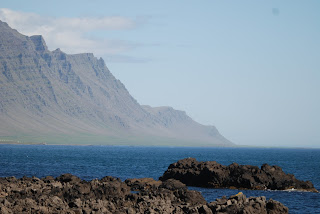Anna wanted to take us up to see Hengifoss and another waterfall even further up. The day before had been hours of hiking through lava fields and we still had a full day ahead of us; I knew that if I made this hike my ankle would be pretty pissed off for the rest of the day so Collette and I and one of our Belgian friends from the tour hung out at the bottom of the waterfall with a few other newfound friends
I would be remiss to post blogs about Iceland without talking about sheep. Sheep, both in wool and meat, is the number one export of Iceland. Like Icelandic horses, the sheep are a breed unique to the island and they are handled in a unique way. All Icelandic sheep are "free range". During summer farmers let their sheep out and they roam wherever they please. The sheep are marked to each farm but they know no boundries. The only bounds they have is that northern sheep are not permitted in the south, southern sheep not permitted in the north, if so they are killed, to keep blood lines pure and to prevent any possible cross contamination. Of course, I doubt many sheep could make it over the pretty much impassable, uninhabited middle of the country
Hengifoss overlooks Hallormsstaoarskogur (it's a language that rolls off the tongue isn't) which is something rare in Iceland; a forest. For two people from Ontario when you say forest it conjures up images of tall trees, leaves, undergrowth ... in Iceland, forest usually means what we call underbrush and even so, that is rare. There is a lot of green in the country, lots of grass but really no forests as we would consider them; hence all the happy sheeps and horses
After our fellow travellers raced up the steep trail as quickly as possible for no reason I could actually understand, we were back on the bus and travelling into the eastern part of the country, passing more unamed (at least to us) waterfalls and more spectacular Iceland landscapes
After travelling a bit, we made a stop for lunch in the fishing village of Djupivogur.
Collette and I had come up with a plan. At an earlier stop at a highway grocery store we had purchased some bread, cheese, cold cuts, fruit, juice etc that would could use to throw together a lunch on the bus, so while the others went to a local cafe we set out to explore the shores of this pretty village where fjord meets ocean meets mountains
On our way out of town Anna had us stop to look at some "dragon eggs". Dragon, perhaps not, but certainly eggs of Iceland, from deep inside the island's womb
Back on the bus and travelling east, passing by Alftafjordur, the swan fjord, named for pretty obvious reasons. There are several swan fjords in Iceland, the most famous is actually in the Western Fjords but this one was pretty impressive too and we were able to see hundreds of swans settled here as part of their annual migration
We continued southeast, into the territory dominated by the Vatnajokull ice cap, the largest glacier in Europe. We could see it dominating the skyline and would occasionally pass by enormous glacial tongues that poured down the sides of the massive cap
We would be going up on to the glacier proper another day but this day our destination was a glacial lagoon, where chunks off ice break off from the ice cap, bob into the lagoon as ice bergs then float their way out to sea
We boarded an amphibious craft that took us right out on to the lake, cruising around the bergs that offered an amazing variety, some as tall as three story buildings, some the size of a couch, all shapes and sizes and colours, some mostly snow, some lace like ice, many of them striped by the as from the recent volcanic activity
We were having another truly glorious day, the sun was shining, it was quite mild, the lake was very calm and although the boat's motor was a bit rumbly, it was a perfect situation in which to watch the ice bergs float by on their way to the sea
Here is a remarkable shot that Collette got looking across the ice bergs up the glacial tongue with the glacier looming in the distance
The day was almost over but we were in Siggi's part of the country and he knew that several us showed an interest in old cemeteries. He took us to one of the most unique ones in Iceland, located behind this preserved church with an old style sold roof
This was a Catholic church, who Anna liked to tell us the Icelanders "kicked" out of the country about 1,000 years ago but there was still a remnant of a stoup that once contained holy water
As you'll see in the video the graves are all above ground, the only place in the country where this is so. Anna was not sure why they did this but being Iceland, I suspect it has something to do with geology





























No comments:
Post a Comment